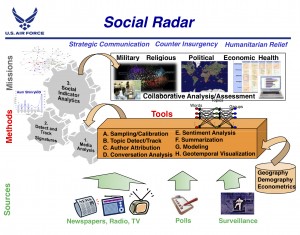Madison Ruppert, Contributing Writer
Activist Post
Dr. Mark Maybury, the United States Air Force Chief Scientist, is stepping outside of the typical areas in which an Air Force Chief Scientist operates and into the digital realm.
Maybury seeks to develop something he has dubbed “Social Radar” which would monitor information coming from just about every source imaginable: television, all Internet communications, radio, official reports, and more, in order to look into the hearts and minds of target populations and perhaps even predict future events.
The Department of Defense (DOD) and Defense Advanced Research Projects Agency (DARPA) have been working on technology along these lines for some time now, but Maybury’s vision seems even more expansive and hard to believe than anything I’ve previously heard of or read about.
Maybury outlined his vision of a Social Radar in a 2010 paper for the MITRE Corporation, a government-funded entity.
This 11-page paper outlines just a few of the possible sources of data and the goals the military has in mind for such a system, which are ambitious to say the least.
Maybury chose Social Radar for a reason as he sees a strong parallel between his vision and more traditional sensors.
“The Air Force and the Navy in this and other countries have a history of developing Sonar to see through the water, Radar to see through the air, and IR [infrared] to see through the night. Well, we also want to see into the hearts and minds of people,” Maybury said to Wired’s Danger Room.
However, Social Radar is quite different from traditional sensor technologies in that it would not be a single sensor like a fixed Radar installation, instead employing a massive amount of different technologies across many disciplines in order to create the most complete picture possible.
Also quite different from the run-of-the-mill physical sensor is the fact that Social Radar actually hopes to see into the future in order to give predictive intelligence for the military.
The previous failures of these technologies have become quite well known, with the Pentagon failing to predict the uprising in Egypt with their extensive, not to mention ludicrously expensive, technology.
Noah Shachtman, writing for Danger Room, says that the Social Radar vision is “part of a broader Pentagon effort to master the societal and cultural elements of war – [an] effort that even many int he Defense Department believe is deeply flawed.”
Many argue that humans are truly unpredictable beings and thus any attempts at predicting future events based on present information is doomed to fail.
However, they said similar things about creating algorithms to predict and game financial markets, but high-frequency trading has proven that it indeed can be profitable.
Danger Room mentions the Pentagon’s downgrading of the role of counterinsurgency (COIN) operations in their strategy revamp, while also pointing out that the need to find potential flashpoints is not going away any time soon.
However, they seem to be taking the position of our military complex, which has become so obsessed with interventionism and nation building.
They cite the need “to understand how American actions might impact those restive populations” in conflict areas, while failing to point out that what Americans should be doing is staying out of the lives of such restive populations entirely.
They mention the fact that American special forces are training foreign armed forces around the world, aptly point out that such actions are “impacting the people of those countries” while failing to point out just how fruitless such strategies are.
Of course, they are only fruitless for those who seek peace and order; for those who rake in massive profits from chaos, war and death, they are likely giddy at the prospect of the United States training troops abroad in order to continue the cycle of violence.
They also mention “the geopolitical chess match with China,” along with covert wars in Yemen, Pakistan and Mexico, all which “require deep knowledge of all the pieces on the board,” but once again fail to even consider the possibility of the United States not taking a confrontational approach to the world.
In researching this field I have come to the realization that the vast majority of journalists, authors and researchers fail to even consider the fact that this conflict-oriented approach need not be a given.
The concept of Social Radar is much like what the Department of Homeland Security (DHS) is already doing in the United States.
However, it appears that Maybury’s Social Radar would be much more comprehensive in the media it collects compared to the domestic programs which mostly monitor social media websites, blogs, social media trend tracking websites, news websites, etc. Whereas, Social Radar would integrate just about everything you can think of.
The domestic programs being used to spy on the American people currently, like Maybury’s Social Radar, regularly claim to be preserving the privacy of users, or in the case of the domestic programs, they claim they do not collect Personally Identifiable Information (PII).
However, Maybury admits himself just a few paragraphs after making the claim that Social Radar will indeed use biometrics to identify people and sociometrics to identify groups.
Maybury calls this creating “signatures” which can be used to track and identify various target individuals, groups, sentiments and/or behaviors.
He also emphasizes the need to keep the collection passive and anonymous, bypassing attempts at deception, obfuscation, and censorship.
Considering all of these factors and the so-called signatures Social Radar will use, it is hardly arguable that the privacy of users will be preserved.
In a time when the United States has absolutely nothing to spend, Maybury’s project seems wildly over the top and a massive waste of taxpayer funds.
Even Danger Room has to note the seeming absurdity of this project writing, “It sounds almost laughably ambitious. And Maybury agrees the notion may be more of a long-term ‘organizing metaphor’ than a particular program.”
However, Maybury argues that the foundation of Social Radar is already there with the MITRE Corporation pursuing several projects which could help realize his vision.
One of the most critical aspects of the Social Radar would be so-called “sentiment analysis,” which attempts to discern whether a piece of writing is positive or negative in sentiment.
This is much like what the “Webbot” supposedly does in order to create trend forecasts.
Such aggregated sentiment analysis would then be tied to geographical locations, and tracked in real time, very similar to what the Federal Reserve is trying to do in the United States, but likely even more sophisticated.
The Pentagon has already spent over $125 million (that we know of; given the massive black budgets that exist the number might be much larger) over three years on technology which attempts to quantify model and foresee human, social, cultural and behavioral (HSCB) factors.
HSCB systems are already being used in several American military units around the world.
The Integrated Crisis Early Warning System (ICEWS) run by DARPA is set to be expanded into six DOD geographical commands, totaling some 175 different nations.
There is a great deal of opposition to technology like this, even within the Pentagon itself.
One internal review of HCSB projects pointed out that, “Project supporters have marshaled evidence to demonstrate the validity of its approach, while critics have pointed to deficiencies in the scorekeeping method that exaggerate the accuracy of ICEWS forecasts.”
Commenting on the viability of this approach, Lieutenant General Paul Van Riper (retired) said, “They are smoking something they shouldn’t be,” to Science magazine.
However, Maybury sees it quite differently, saying, “Just like nobody could imagine seeing through the night or seeing through water, nobody can imagine seeing attitudes. And actually, in my view, that’s very much a future reality.”
Danger Room points to some related projects like a study funded by the Air Force Research Lab carried out by David Matsumoto, a San Francisco State University psychology professor, which is trying to discover “universal markers of deception.”
They also point to a presentation by Maybury on the Air Force’s “contributions” to the military’s HCSB efforts.
In this presentation, Maybury cites a city-wide spying program called “Metropolitan Area Persistent Sensing” along with some other dubious projects like “micro munitions that limit collateral damage” along with “non lethal directed energy weapons” like the now infamous “pain ray” which was reportedly scrapped after being deployed to Afghanistan.
Maybury laughably says that these supposedly non-lethal technologies (which aren’t always non-lethal as we saw in the case of Nick Christie who was murdered by police who sprayed his naked body with pepper spray many times) are important because “preservation of human life is a premium when one is attempting to generate support of the local population, stability and security while not increasing grievances.”
Yet, like the author of the article itself, Maybury seems to pass over the possibility that we might be much better off not even involving ourselves in situations which require “attempting to generate support of the local population.”
When we have record numbers of Americans struggling to find food to eat, or afford a roof over their head, should we really be spending countless amounts of money in foreign nations?
Maybe our military could benefit from stepping back and considering the fact that we do not need to pursue this technology at all if we do not plan on engaging in perpetual war which, unfortunately, seems to be exactly what “the powers that be” intend to do.
This article first appeared at EndtheLie.com
linkwithin_text=’Related Articles:’





Be the first to comment on "The US Air Force wants to monitor, track and analyze everything done on the Internet around the globe"